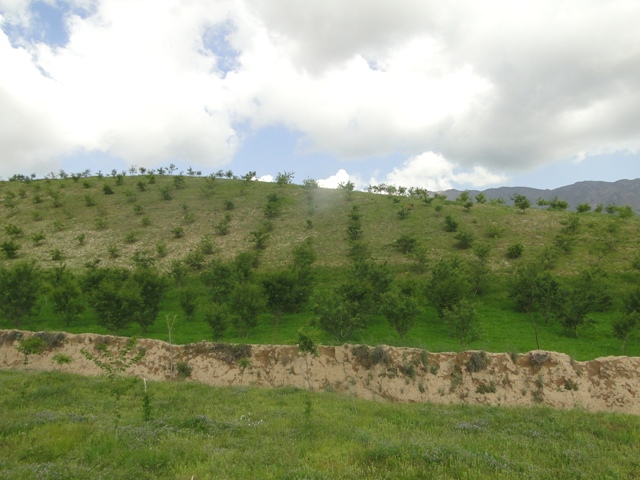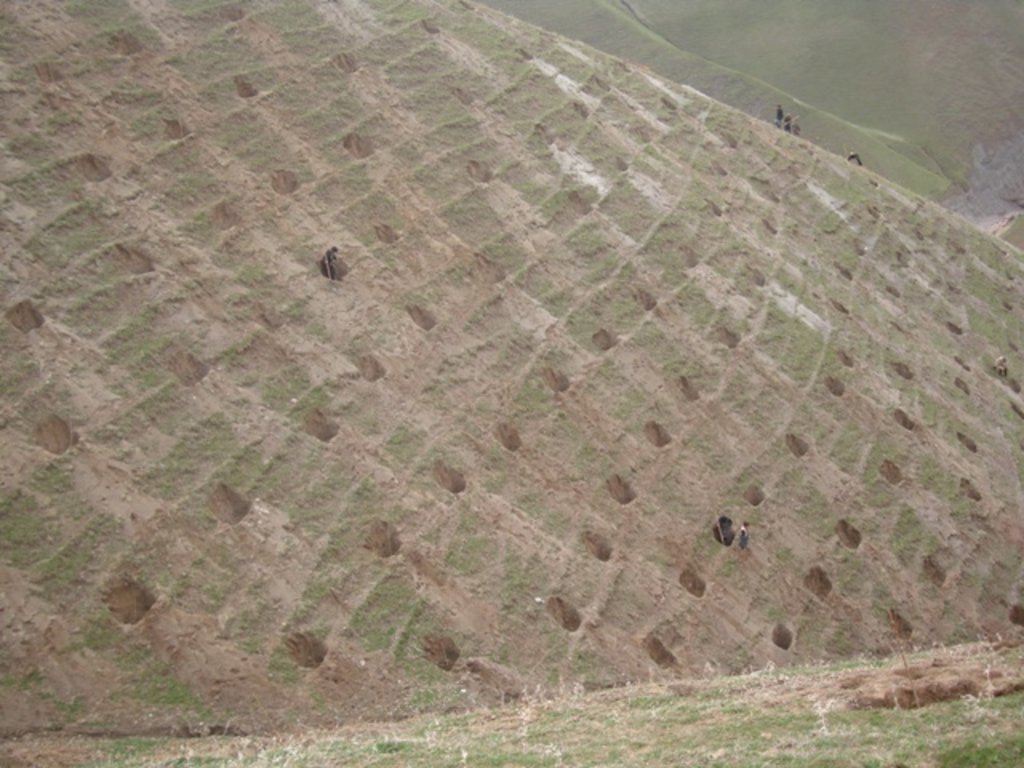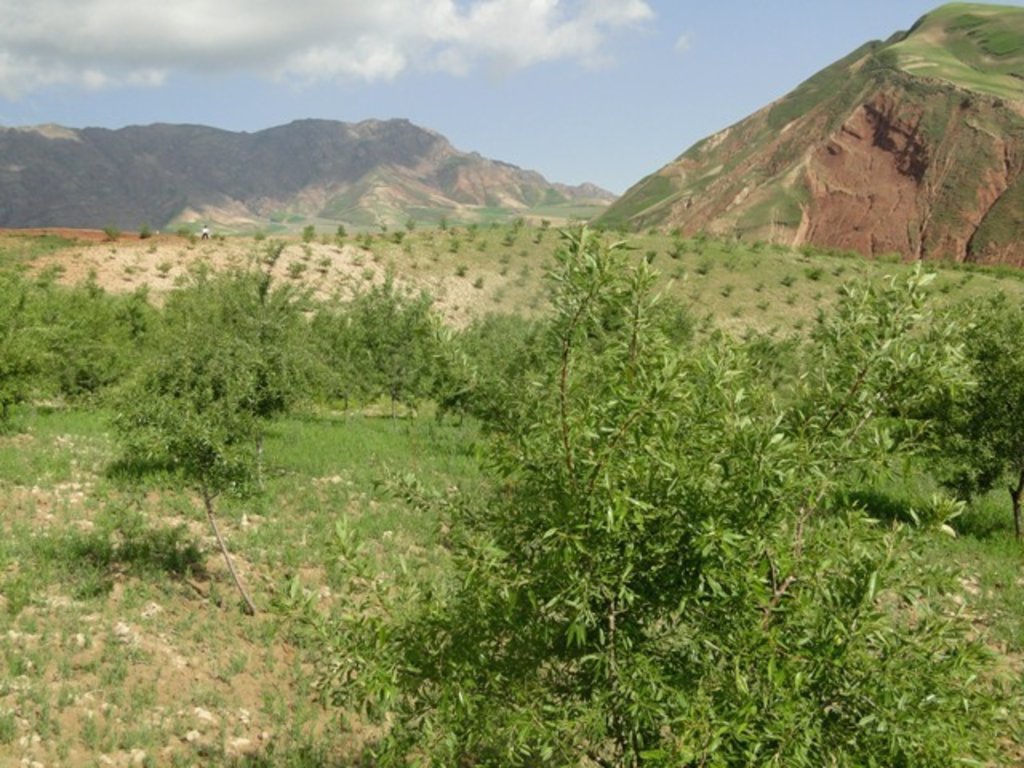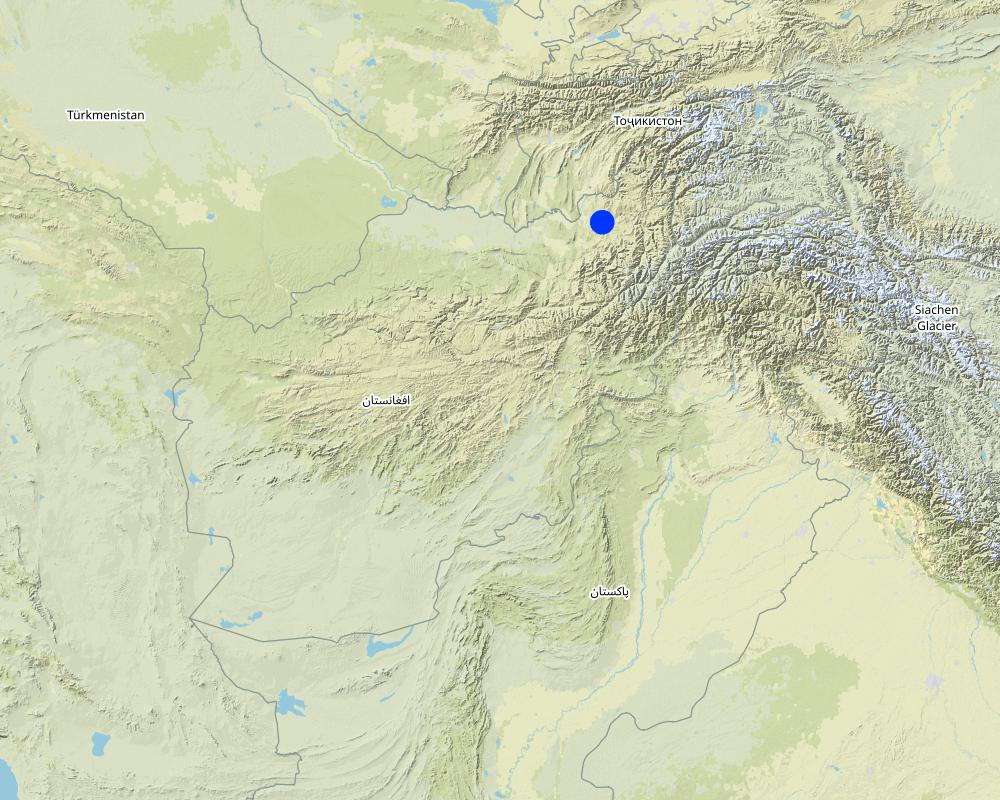Afforestation for firewood production [อัฟกานิสถาน]
- ผู้สร้างสรรค์:
- การอัพเดท:
- ผู้รวบรวม: Bettina Wolfgramm
- ผู้เรียบเรียง: MIAJAN MAROOFI, Hekmatullah Sharifzai, Roziya Kirgizbekova, Aslam Qadamov, Aqila Haidery
- ผู้ตรวจสอบ: William Critchley
Bunyodi jangal baroi tavlidi chubi sukht
technologies_668 - อัฟกานิสถาน
ดูส่วนย่อย
ขยายทั้งหมด ย่อทั้งหมด1. ข้อมูลทั่วไป
1.2 รายละเอียดที่ติดต่อได้ของผู้รวบรวมและองค์กรที่เกี่ยวข้องในการประเมินและการจัดเตรียมทำเอกสารของเทคโนโลยี
วิทยากรหลัก
ผู้ใช้ที่ดิน:
Mohammad Azim Habibullah
Natural Resources Management Comittee (NRMC)
Sari Joy Village, Rustaq District
อัฟกานิสถาน
ผู้เชี่ยวชาญ SLM:
ผู้เชี่ยวชาญ SLM:
Researcher:
ชื่อของโครงการซึ่งอำนวยความสะดวกในการทำเอกสารหรือการประเมินเทคโนโลยี (ถ้าเกี่ยวข้อง)
Potential and limitations for improved natural resource management (NRM) in mountain communities in the Rustaq district, Afghanistan (Rustaq NRM Study)ชื่อของโครงการซึ่งอำนวยความสะดวกในการทำเอกสารหรือการประเมินเทคโนโลยี (ถ้าเกี่ยวข้อง)
Livelihood Improvement Project Takhar, Afghanistan (LIPT)ชื่อขององค์กรซึ่งอำนวยความสะดวกในการทำเอกสารหรือการประเมินเทคโนโลยี (ถ้าเกี่ยวข้อง)
Terre des Hommes (Terre des Hommes) - สวิตเซอร์แลนด์ชื่อขององค์กรซึ่งอำนวยความสะดวกในการทำเอกสารหรือการประเมินเทคโนโลยี (ถ้าเกี่ยวข้อง)
Swiss Agency for Development and Cooperation (DEZA / COSUDE / DDC / SDC) - สวิตเซอร์แลนด์ชื่อขององค์กรซึ่งอำนวยความสะดวกในการทำเอกสารหรือการประเมินเทคโนโลยี (ถ้าเกี่ยวข้อง)
CDE Centre for Development and Environment (CDE Centre for Development and Environment) - สวิตเซอร์แลนด์ชื่อขององค์กรซึ่งอำนวยความสะดวกในการทำเอกสารหรือการประเมินเทคโนโลยี (ถ้าเกี่ยวข้อง)
Bern University of Applied Sciences, School of Agricultural, Forest and Food Sciences (HAFL) - สวิตเซอร์แลนด์1.3 เงื่อนไขการใช้ข้อมูลที่ได้บันทึกผ่านทาง WOCAT
วันที่เก็บรวบรวมข้อมูล(ภาคสนาม) :
27/10/2016
ผู้รวบรวมและวิทยากรหลักยอมรับเงื่อนไขเกี่ยวกับการใช้ข้อมูลที่ถูกบันทึกผ่านทาง WOCAT:
ใช่
1.4 การเปิดเผยเรื่องความยั่งยืนของเทคโนโลยีที่ได้อธิบายไว้
เทคโนโลยีที่ได้อธิบายไว้นี้เป็นปัญหาของความเสื่อมโทรมโทรมของที่ดินหรือไม่ จึงไม่ได้รับการยอมรับว่าเป็นเทคโนโลยีเพื่อการจัดการที่ดินอย่างยั่งยืน:
ไม่ใช่
แสดงความคิดเห็น:
SLM practices documented in the frame of the Rustaq NRM study were established only recently (1-3 years ago). It is too early for a final judgment on the sustainability of these technologies within the human and natural environment of Chokar watershed.
2. การอธิบายลักษณะของเทคโนโลยี SLM
2.1 การอธิบายแบบสั้น ๆ ของเทคโนโลยี
คำจำกัดความของเทคโนโลยี:
Non-fruit and fruit trees are planted on heavily degraded forest land to protect the land from erosion and further degradation and provide fuelwood for the local community.
2.2 การอธิบายแบบละเอียดของเทคโนโลยี
คำอธิบาย:
Project supported implementation of afforestation has taken place in the villages of Sari Joy, Jawaz Khana and Dashti Mirzai, located in Chokar watershed of Rustaq District in Northern Afghanistan. The Chokar watershed is a mountainous area situated between 600 and 2,500 m above sea level. The climate is semi-arid with harsh and cold weather in winter, and hot and dry summers. The annual precipitation in average years is 580 mm. Land degradation affects all forms of land use, and includes low levels of vegetation cover, severe water erosion of topsoil, and poor soil fertility. Unsustainable agricultural practices, over-exploitation and high pressure on the natural resources are adversely impacting the socio-economic well-being of local communities, as well as contributing to the risk of being adversely affected by drought - and landslides and flash foods triggered by heavy rainfall. The data used for the documentation of the technology are based on field research conducted in Chokar watershed, namely in the villages of Sari Joy, Jawaz Khana and Dashti Mirzai. These villages represent the upper, the middle and the lower zones of Chokar watershed, respectively. They differ considerably in access to services and infrastructure, but in general are poorly served. The communities depend on land resources for sustaining their livelihoods. In a good year with high yields, wheat self-sufficiency lasts about 5 months. The three villages are home to ethnic Qarluq communities. Since 2012 the Livelihood Improvement Project Takhar (LIPT) implemented by Terre des hommes (Tdh) Switzerland has initiated a range of NRM interventions
Despite the low forest cover in Rustaq, Afghanistan, local communities strongly rely on fuelwood and animal dung for cooking and heating throughout the whole year. Forests are mainly found on community land with open access to all, and there are no protection measures in place. The high demand on fuelwood for household needs places strong pressure on the remaining patches of forests and bushes, which are currently threatened by eradication. Such high demand in the area is likely to remain as there are no other alternative energy sources. The mass destruction of local forests is one of the main causes of intensive erosion, aridification, loss of topsoil and formation of gullies. Low forest cover increases vulnerability to severe rainfall and risks of landslides.
Afforestation measures in the three villages were initiated to halt the land degradation and provide sustainable firewood. The reforestation sites are largely on community land with a small share on private land. The area is characterized by hilly (16-30%) and steep (31-60%) slopes. Planting and maintaining forest in such conditions requires close support in the appropriate design of forest plots, and relevant maintenance recommendations, which can then ensure the survival of the plantation. A plot of 0.2 ha is divided into 4 m x 3 m sections. Each tree is placed in a pit of 50 cm x 30 cm with rich soil around the roots. Once the tree is planted, it is watered and covered with lime. Russian willow, acacia, mulberry and almond are the most common tree species used for afforestation purposes.
Most of the newly established forest sites are located at walking distance of the nearby villages: this is important to help provide protection of the plot from animal intrusion and ensure proper maintenance of the trees. The forest plot is watered for three years in a row. The Natural Resources Management Committees (NRMC) pays 0.60 US cents per tree per year to sustain the survival of the plantation within the first year. The funding for the irrigation is provided by the Livelihood Improvement Project Takhar (LIPT). LIPT supported the afforestation activities through the provision of technical and financial support. The tree seedlings were supplied by the project, and financial incentives were provided to engage the community in tree-planting.
The plantations are still very young: however, the land users express support for the new forest in their villages, and have observed localized stabilization of the soil and improvement in vegetation cover. There are high expectations of the new forest, which promises access to sustainable fuelwood and non-forest products, such as almonds and mulberry. The grass and tree leaves from the forest plots are already used for animal fodder.
Women and children under 15 years old are expected to be the direct beneficiaries of the new forest. They will no longer spend long hours to collect and deliver fuelwood, bushes and dung. A small portion of women reported involvement in forest establishment activities, while the majority are taking part in protecting the forests from livestock.
2.3 รูปภาพของเทคโนโลยี
2.5 ประเทศภูมิภาค หรือสถานที่ตั้งที่เทคโนโลยีได้นำไปใช้และได้รับการครอบคลุมโดยการประเมินนี้
ประเทศ:
อัฟกานิสถาน
ภูมิภาค/รัฐ/จังหวัด:
Takhar Province, Rustaq District
ข้อมูลจำเพาะเพิ่มเติมของสถานที่ตั้ง :
Sari Joy, Jawaz Khana, Dashti Mirzai
แสดงความคิดเห็น:
This documentation is based on the experiences of SLM impementers from Sari Joy (5 plots), Jawaz Khana, (4 plots), and Dashti Mirzai (3 plots) as compiled during focus group discussions. Additionally insights were gained through interviews in all three villages on farmers experiences and observations of afforestation plots, with both SLM implementers (20) and observers (10).
Map
×2.6 วันที่การดำเนินการ
ถ้าไม่รู้ปีที่แน่นอน ให้ระบุวันที่โดยประมาณ:
- น้อยกว่า 10 ปี (ไม่นานนี้)
2.7 คำแนะนำของเทคโนโลยี
ให้ระบุว่าเทคโนโลยีถูกแนะนำเข้ามาอย่างไร:
- ทางโครงการหรือจากภายนอก
ความคิดเห็น (ประเภทของโครงการ เป็นต้น) :
Livelihood Improvement Project Takhar (LIPT) supported by Swiss Development Cooperation (SDC) from 2012-17
3. การจัดประเภทของเทคโนโลยี SLM
3.1 วัตถุประสงค์หลักของเทคโนโลยี
- ปรับปรุงการผลิตให้ดีขึ้น
- ลด ป้องกัน ฟื้นฟู การเสื่อมโทรมของที่ดิน
- ลดความเสี่ยงของภัยพิบัติ
3.2 ประเภทของการใช้ที่ดินในปัจจุบันที่ได้นำเทคโนโลยีไปใช้

การใช้ที่ดินแบบผสมผสาน (รวมถึงวนเกษตร)
- ปศุสัตว์ร่วมกับการทำป่าไม้ (Silvo-pastoralism)
ผลิตภัณฑ์หลักหรือบริการ:
Acacia, Russian willow, mulberry. almond, grass and leaves for fodder
ถ้าการใช้ที่ดินมีการเปลี่ยนแปลงเนื่องมาจากการนำเทคโนโลยีไปปฏิบัติใช้ ให้ระบุการใช้ที่ดินก่อนนำเทคโนโลยีไปปฏิบัติใช้:
Some of the forest land has been heavily degraded and was used as grazing land for an extensive period. Most of the land is forest land.
3.3 ข้อมูลเพิ่มเติมเกี่ยวกับการใช้ที่ดิน
การใช้น้ำของที่ดินที่มีการใช้เทคโนโลยีอยู่:
- น้ำฝนร่วมกับการชลประทาน
แสดงความคิดเห็น:
During the first three years the forest requires irrigation due to aridity. The first year of irrigation is supported by the project, and the rest of the irrigation measures are implemented by the local community with the support of the NRMC.
จำนวนของฤดูเพาะปลูกต่อปี:
- 1
3.4 กลุ่ม SLM ที่ตรงกับเทคโนโลยีนี้
- การปรับปรุงดิน / พืชคลุมดิน
3.5 กระจายตัวของเทคโนโลยี
ระบุการกระจายตัวของเทคโนโลยี:
- กระจายไปอย่างสม่ำเสมอในพื้นที่
ถ้าหากว่าเทคโนโลยีได้มีการกระจายออกไปอย่างสม่ำเสมอในพื้นที่ ให้ระบุปริมาณพื้นที่ที่ได้รับการครอบคลุมถึง:
- 0.1-1 ตร.กม.
แสดงความคิดเห็น:
23.6 ha
3.6 มาตรการ SLM ที่ประกอบกันเป็นเทคโนโลยี

มาตรการอนุรักษ์ด้วยวิธีพืช
- V1: ต้นไม้และพุ่มไม้คลุมดิน
- V2: หญ้าและไม้ยืนต้น

มาตรการอนุรักษ์ด้วยการจัดการ
- M1: การเปลี่ยนรูปแบบของการใช้ประโยชน์ที่ดิน
3.7 รูปแบบหลักของการเสื่อมโทรมของที่ดินที่ได้รับการแก้ไขโดยเทคโนโลยี

การกัดกร่อนของดินโดยน้ำ
- Wt (Loss of topsoil): การสูญเสียดินชั้นบนหรือการกัดกร่อนที่ผิวดิน

การกัดกร่อนของดินโดยลม
- Et (Loss of topsoil): การสูญเสียดินชั้นบน

การเสื่อมโทรมของดินทางด้านชีวภาพ
- Bc (Reduction of vegetation cover): การลดลงของจำนวนพืชที่ปกคลุมดิน
- Bq (Quantity/biomass decline): การลดลงของปริมาณหรือมวลชีวภาพ

การเสื่อมโทรมของน้ำ
- Ha (Aridification): การเกิดความแห้งแล้ง
3.8 การป้องกัน การลดลง หรือการฟื้นฟูความเสื่อมโทรมของที่ดิน
ระบุเป้าหมายของเทคโนโลยีกับความเสื่อมโทรมของที่ดิน:
- ลดความเสื่อมโทรมของดิน
- ฟื้นฟูบำบัดที่ดินที่เสื่อมโทรมลงอย่างมาก
4. ข้อมูลจำเพาะด้านเทคนิค กิจกรรมการนำไปปฏิบัติใช้ ปัจจัยนำเข้า และค่าใช้จ่าย
4.1 แบบแปลนทางเทคนิคของเทคโนโลยี
ผู้เขียน:
Aslam Qadamov; Roziya Kirgizbekova
วันที่:
03/04/2017
4.2 ข้อมูลจำเพาะด้านเทคนิคและการอธิบายแบบแปลนทางเทคนิค
The establishment activities begin with selecting the area for reforestation. Most of the reforestation sites are on slopes above 6% steepness . A plot of 0.2 ha is divided into 4 m x 3 m sections. Planting pits of 50 cm x 30 cm are prepared for planting the trees. Each tree is placed in a pit and good soil is added to the roots. Most popular species used for reforestation are: Russian willow, acacia and mulberry. The newly planted tree is watered and the trunk is covered with a lime and water solution for protection and better growth.
4.3 ข้อมูลทั่วไปเกี่ยวกับการคำนวณปัจจัยนำเข้าและค่าใช้จ่าย
ให้ระบุว่าค่าใช้จ่ายและปัจจัยนำเข้าได้รับการคำนวณอย่างไร:
- ต่อพื้นที่ที่ใช้เทคโนโลยี
ระบุขนาดและหน่วยพื้นที่:
1 ha
ระบุสกุลเงินที่ใช้คำนวณค่าใช้จ่าย:
- ดอลลาร์สหรัฐ
ระบุอัตราแลกเปลี่ยนจากดอลลาร์สหรัฐเป็นสกุลเงินท้องถิ่น (ถ้าเกี่ยวข้อง) คือ 1 เหรียญสหรัฐ =:
67.0
ระบุค่าเฉลี่ยของค่าจ้างในการจ้างแรงงานต่อวัน:
5.2-5.3 USD
4.4 กิจกรรมเพื่อการจัดตั้ง
| กิจกรรม | ประเภทของมาตรการ | ช่วงเวลาดำเนินการ | |
|---|---|---|---|
| 1. | Design of the forest plot | ด้วยการจัดการ | Winter |
| 2. | Digging pits 50 cmx 30 cm for tree plantation | ด้วยโครงสร้าง | End of winter |
| 3. | Planting tree seedlings 3m x 4m | ด้วยวิธีพืช | Spring/Rainy season |
| 4. | Watering the tree after planting | ด้วยวิธีพืช | Spring |
| 5. | Covering the tree with lime | มาตรการอื่น ๆ | Spring |
4.5 ค่าใช้จ่ายของปัจจัยนำเข้าที่จำเป็นสำหรับการจัดตั้ง
| ปัจจัยนำเข้า | หน่วย | ปริมาณ | ค่าใช้จ่ายต่อหน่วย | ค่าใช้จ่ายทั้งหมดต่อปัจจัยนำเข้า | %ของค่าใช้จ่ายที่ก่อให้เกิดขึ้นโดยผู้ใช้ที่ดิน | |
|---|---|---|---|---|---|---|
| แรงงาน | Design of the forest | person-day | 15.0 | 5.3 | 79.5 | |
| แรงงาน | Digging pits/holes for the trees | person-day | 22.0 | 5.3 | 116.6 | |
| แรงงาน | Planting tree seedlings and watering | person-day | 15.0 | 5.3 | 79.5 | |
| แรงงาน | Fertilizer and lime application | person-day | 8.0 | 5.3 | 42.4 | |
| อุปกรณ์ | Meter | piece | 1.0 | 2.25 | 2.25 | |
| อุปกรณ์ | Shovel | piece | 2.0 | 3.8 | 7.6 | |
| อุปกรณ์ | Pickaxe | piece | 1.0 | 2.25 | 2.25 | |
| อุปกรณ์ | Rope | meter | 500.0 | 0.07 | 35.0 | |
| วัสดุด้านพืช | Accacia seedlings | piece | 275.0 | 0.45 | 123.75 | |
| วัสดุด้านพืช | Russian willow seedlings | piece | 275.0 | 0.45 | 123.75 | |
| วัสดุด้านพืช | Mulberry seedlings | piece | 275.0 | 0.45 | 123.75 | |
| ปุ๋ยและสารฆ่า/ยับยั้งการเจริญเติบโตของสิ่งมีชีวิต (ไบโอไซด์) | DAP | kg | 250.0 | 0.9 | 225.0 | |
| ปุ๋ยและสารฆ่า/ยับยั้งการเจริญเติบโตของสิ่งมีชีวิต (ไบโอไซด์) | Lime | kg | 25.0 | 1.5 | 37.5 | |
| ค่าใช้จ่ายทั้งหมดของการจัดตั้งเทคโนโลยี | 998.85 | |||||
ถ้าผู้ใช้ที่ดินรับภาระน้อยกว่า 100% ของค่าใช้จ่าย ให้ระบุว่าใครเป็นผู้รับผิดชอบส่วนที่เหลือ:
Livelihood Improvement Project Takhar (LIPT) implemented by Terre des hommes (Tdh) Switzerland
แสดงความคิดเห็น:
Costs calculated for a Technology area of 1ha was only done for the purpose of the WOCAT documentation. In reality SLM plots are on average 0.4 ha or 2 jiribs. Costs were simply multiplied by 2.5. The actual costs for a 1ha plot might be slightly different.
4.6 การบำรุงรักษาสภาพหรือกิจกรรมที่เกิดขึ้นเป็นประจำ
| กิจกรรม | ประเภทของมาตรการ | ช่วงระยะเวลา/ความถี่ | |
|---|---|---|---|
| 1. | Protecting the trees from livestock | ด้วยการจัดการ | Spring/Summer |
| 2. | Pest and disease control | ด้วยวิธีพืช | Spring |
| 3. | Irrigation | จัดการพืช | Summer/First three years |
| 4. | Replanting dead trees | ด้วยวิธีพืช | Spring |
| 5. | Pruning | จัดการพืช | Spring |
4.7 ค่าใช้จ่ายของปัจจัยนำเข้าและกิจกรรมที่เกิดขึ้นเป็นประจำที่ต้องการการบำรุงรักษา (ต่อปี)
| ปัจจัยนำเข้า | หน่วย | ปริมาณ | ค่าใช้จ่ายต่อหน่วย | ค่าใช้จ่ายทั้งหมดต่อปัจจัยนำเข้า | %ของค่าใช้จ่ายที่ก่อให้เกิดขึ้นโดยผู้ใช้ที่ดิน | |
|---|---|---|---|---|---|---|
| แรงงาน | Pest and disease control | person day | 7.5 | 5.3 | 39.75 | 100.0 |
| แรงงาน | Replanting dead trees | person day | 7.5 | 5.3 | 39.75 | 100.0 |
| แรงงาน | Irrigating the trees | person day | 10.0 | 5.3 | 53.0 | 100.0 |
| แรงงาน | Pruning | person day | 5.0 | 5.3 | 26.5 | 100.0 |
| ค่าใช้จ่ายทั้งหมดของการบำรุงรักษาสภาพเทคโนโลยี | 159.0 | |||||
แสดงความคิดเห็น:
Costs calculated for a Technology area of 1ha was only done for the purpose of the WOCAT documentation. In reality SLM plots are on average 0.4 ha or 2 jiribs. Costs were simply multiplied by 2.5. The actual costs for a 1ha plot might be slightly different.
4.8 ปัจจัยสำคัญที่สุดที่มีผลกระทบต่อค่าใช้จ่าย
ปัจจัยสำคัญที่สุดที่มีผลกระทบต่อค่าใช้จ่ายต่างๆ:
Due to the remoteness of the villages where the technology has been implemented, all the inputs for establishment, such as agricultural equipment, plant material, fertilizers, etc., are purchased in Rustaq town. The expenses for traveling and delivering the inputs affect the establishment costs.
5. สิ่งแวดล้อมทางธรรมชาติและของมนุษย์
5.1 ภูมิอากาศ
ฝนประจำปี
- < 250 ม.ม.
- 251-500 ม.ม.
- 501-750 ม.ม.
- 751-1,000 ม.ม.
- 1,001-1,500 ม.ม.
- 1,501-2,000 ม.ม.
- 2,001-3,000 ม.ม.
- 3,001-4,000 ม.ม.
- > 4,000 ม.ม.
ระบุปริมาณน้ำฝนเฉลี่ยรายปี (ถ้ารู้) :หน่วย ม.ม.
564.00
ข้อมูลจำเพาะ/ความคิดเห็นเรื่องปริมาณน้ำฝน:
Average annual precipitation for the area was calculated with 564 mm, with minimum in dry years (2000 and 2001) of 270 mm and maximum in wet years (2009/2010) of 830 mm. The absolute maximum rainfall was calculated for 1986 with 1024 mm. The data series covers the time from 1979 to 2014.
ระบุชื่อของสถานีตรวดวัดอากาศที่ใช้อ้างอิงคือ:
Climate Forecast System Reanalysis (CFSR), http://rda.ucar.edu/pub/cfsr.html
เขตภูมิอากาศเกษตร
- กึ่งแห้งแล้ง
Derived from the publicly available dataset on length of growing period (LGP) (Fischer 2009 / IIASA-FAO). Internet link: http://tiles.arcgis.com/tiles/P8Cok4qAP1sTVE59/arcgis/rest/services/Length_of_growing_period/MapServer
5.2 สภาพภูมิประเทศ
ค่าเฉลี่ยความลาดชัน:
- ราบเรียบ (0-2%)
- ลาดที่ไม่ชัน (3-5%)
- ปานกลาง (6-10%)
- เป็นลูกคลื่น (11-15%)
- เป็นเนิน (16-30%)
- ชัน (31-60%)
- ชันมาก (>60%)
ธรณีสัณฐาน:
- ที่ราบสูง/ที่ราบ
- สันเขา
- ไหล่เขา
- ไหล่เนินเขา
- ตีนเนิน
- หุบเขา
ระดับความสูง:
- 0-100 เมตร
- 101-500 เมตร
- 501-1,000 เมตร
- 1,001-1,500 เมตร
- 1,501-2,000 เมตร
- 2,001-2,500 เมตร
- 2,501-3,000 เมตร
- 3,001-4,000 เมตร
- > 4,000 เมตร
5.3 ดิน
ค่าเฉลี่ยความลึกของดิน:
- ตื้นมาก (0-20 ซ.ม.)
- ตื้น (21-50 ซ.ม.)
- ลึกปานกลาง (51-80 ซ.ม.)
- ลึก (81-120 ซ.ม.)
- ลึกมาก (>120 ซ.ม.)
เนื้อดิน (ดินชั้นบน):
- ปานกลาง (ดินร่วน ทรายแป้ง)
เนื้อดินล่าง (> 20 ซ.ม.ต่ำจากผิวดิน):
- ปานกลาง (ดินร่วน ทรายแป้ง)
อินทรียวัตถุในดิน:
- ปานกลาง (1-3%)
- ต่ำ (<1%)
(ถ้ามี) ให้แนบคำอธิบายเรื่องดินแบบเต็มหรือระบุข้อมูลที่มีอยู่ เช่น ชนิดของดิน ค่า pH ของดินหรือความเป็นกรดของดิน ความสามารถในการแลกเปลี่ยนประจุบวก ไนโตรเจน ความเค็ม เป็นต้น:
Local land users refer to the soil type where reforestation is implemented as:
Dark soil is characterized as: moderately deep; topsoil texture medium, below surface texture medium; and medium topsoil organic matter.
Light soil is characterized as: moderately deep; texture medium; medium, low organic matter.
5.4 ความเป็นประโยชน์และคุณภาพของน้ำ
ระดับน้ำใต้ดิน:
5-50 เมตร
น้ำไหลบ่าที่ผิวดิน:
ปานกลาง
คุณภาพน้ำ (ที่ยังไม่ได้บำบัด):
เป็นน้ำเพื่อการดื่มที่ดี
ความเค็มของน้ำเป็นปัญหาหรือไม่:
ไม่ใช่
กำลังเกิดน้ำท่วมในพื้นที่หรือไม่:
ใช่
บ่อยครั้ง:
เป็นครั้งเป็นคราว
ความคิดเห็นและข้อมูลจำเพาะเพิ่มเติมเรื่องคุณภาพและปริมาณน้ำ:
Floods occur mainly during the rainy seasons in spring and autumn. Availability of surface water varies in the three study villages. Sari Joy and Dashti Mirzai have good surface water availability, which is also food for drinking. Jawaz Khana has poor water both in quality and availability. Water has to be fetched from a distant stream.
5.5 ความหลากหลายทางชีวภาพ
ความหลากหลายทางชนิดพันธุ์:
- ต่ำ
ความหลากหลายของแหล่งที่อยู่:
- ต่ำ
5.6 ลักษณะของผู้ใช้ที่ดินที่นำเทคโนโลยีไปปฏิบัติใช้
อยู่กับที่หรือเร่ร่อน:
- อยู่กับที่
แนวทางการตลาดของระบบการผลิต:
- เพื่อการยังชีพ (หาเลี้ยงตนเอง)
- ผสม (การเลี้ยงชีพ/ทำการค้า)
รายได้ที่มาจากนอกฟาร์ม:
- 10-50% ของรายได้ทั้งหมด
- > 50% ของรายได้ทั้งหมด
ระดับของความมั่งคั่งโดยเปรียบเทียบ:
- พอมีพอกิน
- รวย
เป็นรายบุคคล/ครัวเรือน:
- เป็นรายบุคคล/ครัวเรือน
- กลุ่ม/ชุมชน
ระดับของการใช้เครื่องจักรกล:
- งานที่ใช้แรงกาย
เพศ:
- หญิง
- ชาย
อายุของผู้ใช้ที่ดิน:
- วัยกลางคน
- ผู้สูงอายุ
ระบุลักษณะอื่นๆที่เกี่ยวข้องของผู้ใช้ที่ดิน:
The land users in the area where the Technology is applied belong to the Uzbek ethnic minority group Qarluq. Although the men are generally the main land users, women and children also take active part in the related work. The functions of men and women are clearly distinguished within the Afghan society. At the same time within the family this division of work and functions also results in men and women working hand-in-hand. An improvement of the family’s livelihood situation is expected to positively affect all family members. While it is recognized that the involvement of women is key in order to secure basic human rights for everyone, to achieve good governance, sustainable development, and to efficiently contribute to poverty reduction (SDC 2004), it is also clear that a context sensitive approach is of high importance.
Women in rural Afghanistan are involved in many production and income generating activities that contribute to the overall household income, however very few women own resources such as land and livestock, and their income generating options are fewer in comparison to that of men.
5.7 พื้นที่เฉลี่ยของที่ดินที่เป็นเจ้าของหรือเช่าโดยผู้ใช้ที่ดินที่นำเทคโนโลยีไปปฏิบัติใช้
- < 0.5 เฮกตาร์
- 0.5-1 เฮกตาร์
- 1-2 เฮกตาร์
- 2-5 เฮกตาร์
- 5-15 เฮกตาร์
- 15-50 เฮกตาร์
- 50-100 เฮกตาร์
- 100-500 เฮกตาร์
- 500-1,000 เฮกตาร์
- 1,000-10,000 เฮกตาร์
- >10,000 เฮกตาร์
พิจารณาว่าเป็นขนาดเล็ก กลาง หรือขนาดใหญ่ (ซึ่งอ้างอิงถึงบริบทระดับท้องถิ่น):
- ขนาดกลาง
5.8 กรรมสิทธิ์ในที่ดิน สิทธิในการใช้ที่ดินและสิทธิในการใช้น้ำ
กรรมสิทธิ์ในที่ดิน:
- เป็นแบบชุมชนหรือหมู่บ้าน
- รายบุคคล ไม่ได้รับสิทธิครอบครอง
สิทธิในการใช้ที่ดิน:
- เกี่ยวกับชุมชน (ถูกจัดระเบียบ)
- รายบุคคล
สิทธิในการใช้น้ำ:
- เกี่ยวกับชุมชน (ถูกจัดระเบียบ)
แสดงความคิดเห็น:
Those who own land and use water for irrigation are obliged to pay for water. The payment is made either in kind or in cash to Mirob - the person in charge of distributing water in the community. The amount of the payment varies from village to village.
6. ผลกระทบและสรุปคำบอกกล่าว
6.1 ผลกระทบในพื้นที่ดำเนินการ (On-site) จากการใช้เทคโนโลยี
ผลกระทบทางด้านเศรษฐกิจและสังคม
การผลิต
การผลิตพืชที่ใช้เลี้ยงปศุสัตว์
การผลิตสัตว์
การผลิตไม้
การผลิตของจากป่าทุกชนิดยกเว้นไม้
ความหลากหลายของผลิตภัณฑ์
ผลกระทบด้านสังคมวัฒนธรรมอื่น ๆ
SLM หรือความรู้เรื่องความเสื่อมโทรมของที่ดิน
แสดงความคิดเห็น/ระบุ:
Land users learned new methods of planting trees based on the local conditions.
สถานการณ์ของกลุ่มด้อยโอกาส ทางด้านสังคมและเศรษฐกิจ
แสดงความคิดเห็น/ระบุ:
The established forest is expected to become a reliable source for firewood, which will decrease the burden of women and children under 15 years, who spend long hours to collect firewood.
ผลกระทบด้านนิเวศวิทยา
วัฐจักรน้ำหรือน้ำบ่า
น้ำไหลบ่าที่ผิวดิน
ดิน
การสูญเสียดิน
ความหลากหลายทางชีวภาพของพืชและสัตว์
การปกคลุมด้วยพืช
6.2 ผลกระทบนอกพื้นที่ดำเนินการ (Off-site) จากการใช้เทคโนโลยี
น้ำท่วมพื้นที่ท้ายน้ำ
การทับถมของดินตะกอนพื้นที่ท้ายน้ำ
ความสามารถต้านทานการเปลี่ยนแปลง / ความสามารถในการคัดกรอง
ความคิดเห็นเกี่ยวกับการประเมินผลกระทบ:
Based on the Land User Protocols: Individual SLM implementers were asked to rate the benefits for their Technology. They were asked to indicate production increase of crops; fodder; animals; wood; non-wood forest products; increase in product diversity; or production area. The most important increase they rated with 3, the second most with 2, others with 1 point. Averages of the points given by all SLM implementers are reflected here.
Based on the Land User Protocols: Individual SLM implementers were asked to rate the on-site and off-site impacts of the Technology on water; soil; and vegetation. They were asked to indicate the strength of impacts with three, two or one points. Averages of the points given by all implementers are reflected here.
6.3 การเผชิญและความตอบสนองของเทคโนโลยีต่อการเปลี่ยนแปลงสภาพภูมิอากาศที่ค่อยเป็นค่อยไป และสภาพรุนแรงของภูมิอากาศ / ภัยพิบัติ (ที่รับรู้ได้โดยผู้ใช้ที่ดิน)
สภาพรุนแรงของภูมิอากาศ (ภัยพิบัติ)
ภัยพิบัติทางอุตุนิยมวิทยา
| เทคโนโลยีมีวิธีการรับมืออย่างไร | |
|---|---|
| พายุฝนประจำท้องถิ่น | ดีมาก |
ภัยพิบัติจากสภาพภูมิอากาศ
| เทคโนโลยีมีวิธีการรับมืออย่างไร | |
|---|---|
| ภัยจากฝนแล้ง | ดี |
แสดงความคิดเห็น:
Based on the multi-criteria matrix: SLM implementers were asked to jointly discuss and rate how much the SLM technology reduced the lands vulnerability to drought and local rainstorms. Only vulnerability to the most prevalent climate extremes (drought and local rainstorms) was discussed. SLM technologies were rated as reducing vulnerability poorly, well, or very well. The average points reflected here are from multi-criteria matrixes compiled in three villages where the SLM technology had been implemented
6.4 การวิเคราะห์ค่าใช้จ่ายและผลประโยชน์ที่ได้รับ
ผลประโยชน์ที่ได้รับเปรียบเทียบกับค่าใช้จ่ายในการจัดตั้งเป็นอย่างไร (จากมุมมองของผู้ใช้ที่ดิน)
ผลตอบแทนระยะสั้น:
ด้านบวกอย่างมาก
ผลตอบแทนระยะยาว:
ด้านบวกอย่างมาก
แสดงความคิดเห็น:
Based on the multi-criteria matrix: During the FGD with SLM implementers, a multi-criteria matrix was elaborated, and different SLM practices were rated. In the framework of this exercise, SLM implementers were asked to jointly discuss and rate short term (1-3 years) and long-term (10 years) returns. As the SLM technology was only implemented 1-2 years ago, it is too early to compare benefits to maintenance costs. Farmers have little experience so far on the actual benefits of the SLM technology. The ratings are mostly based on expected benefits and not on actual benefits.
6.5 การปรับตัวของเทคโนโลยี
- 1-10%
ถ้ามีข้อมูลให้บอกปริมาณด้วย (จำนวนของครัวเรือนหรือครอบคลุมพื้นที่):
23.6 ha have been afforested with LIPT support
จากทั้งหมดที่ได้รับเทคโนโลยีเข้ามามีจำนวนเท่าใดที่ทำแบบทันที โดยไม่ได้รับการจูงใจด้านวัสดุหรือการเงินใด ๆ:
- 10-50%
แสดงความคิดเห็น:
Based on the Land User Protocol: Individual SLM implementers were asked whether they received support for implementing the Technology. Each indicated the type of support he received from the proposed options: "Full Support 100%, Some Support, No Support 0%".
6.6 การปรับตัว
เทคโนโลยีได้รับการปรับเปลี่ยนเมื่อเร็วๆนี้ เพื่อให้ปรับตัวเข้ากับสภาพที่กำลังเปลี่ยนแปลงหรือไม่:
ไม่ใช่
6.7 จุดแข็ง / ข้อได้เปรียบ / โอกาสของเทคโนโลยี
| จุดแข็ง / ข้อได้เปรียบ / โอกาสในทัศนคติของผู้ใช้ที่ดิน |
|---|
| The tree plantations protect the soil from erosion. The land is less vulnerable to heavy rainfall, which washes off the topsoil |
| There are very high expectations about production of firewood. Availability of firewood in local forest will make it much easier to access firewood for cooking and heating by local households. |
| Apart from firewood and wood production, other non-timber products are provided by the afforestation plots, such as fodder for livestock from grass (alfalfa, sainfoin) and tree leaves during autumn. Also some plots are planted with almond and mulberry, which can be collected for own use or for selling. |
| Local people value the recreational benefit of the forest, which make their villages greener and provide green spaces for the local people. |
| จุดแข็ง / ข้อได้เปรียบ / โอกาสในทัศนคติของผู้รวบรวมหรือวิทยากรหลัก |
|---|
| The afforestation measures in the village including establishing the forest and protecting it, mobilizing the community around a common goal, and this has a positive impact on the village as a whole. |
| The planted trees and grass under the trees improve the vegetation cover and increase soil quality, which is then less prone to erosion |
| Improved varieties of fruit and non-fruit tree species used for afforestation help to diversify the tree species in the village and make the soil less resistant to dry spells |
| The expected combined benefits of wood and non-wood products, especially when the harvesting period starts, may have positive impact on households' income and food security. |
6.8 จุดอ่อน / ข้อเสียเปรียบ / ความเสี่ยงของเทคโนโลยีและวิธีการแก้ไข
| จุดอ่อน / ข้อเสียเปรียบ / ความเสี่ยงในทัศนคติของผู้ใช้ที่ดิน | มีวิธีการแก้ไขได้อย่างไร |
|---|---|
| The establishment costs for afforestation measures are very high | |
| The young trees are vulnerability to droughts | |
| During maintenance some plots require irrigation | |
| Afforestation plots, which are established on former grazing land, reduces the grazing land in the village and deprives animals from grazing land |
| จุดอ่อน / ข้อเสียเปรียบ / ความเสี่ยงในทัศนคติของผู้รวบรวมหรือวิทยากรหลัก | มีวิธีการแก้ไขได้อย่างไร |
|---|---|
| Community provides weak or no protection of the afforestation site, which results in low tree survival | |
| Weak funding sources for irrigation of the afforestation plots, particularly during the first three years when the trees are young, might compromise the new plantations | |
| Afforestation is established mostly on community land, where unclear land tenure rights persist, which may cause conflict in the community over forest vs grazing land |
7. การอ้างอิงและการเชื่อมต่อ
7.1 วิธีการและแหล่งข้อมูล
- ไปเยี่ยมชมภาคสนาม การสำรวจพื้นที่ภาคสนาม
No field visits were conducted
- การสัมภาษณ์กับผู้ใช้ที่ดิน
Focus group discussions (FGD) were organized by the CDE team to collect information from SLM implementers. Total of 15 land users who have implemented afforestation, participated in the FGDs held in the three villages of Sari Joy, Jawaz Khana and Dashti Mirzai.
Interviews were conducted by the HAFL team to collect information from persons representing all the three study villages. Very detailed interviews were conducted with 30 persons interested in afforestation implementation, of which 20 persons are from households that already have implemented afforestation.
- การสัมภาษณ์ผู้เชี่ยวชาญด้าน SLM หรือผู้ชำนาญ
Close collaboration took place during the compilation of this material with the technical staff of the LIPT project in Rustaq.
- การเก็บรวบรวมมาจากรายงานและเอกสารที่มีอยู่
Information provided in the reports of the LIPT project in Rustaq served as an initial source of information during the preparatory phase and also solidifying the description of the technology and area of implementation. Other background papers on Afghanistan were referred to for general information on agriculture and natural resource management in Afghanistan.
7.2 การอ้างอิงถึงสิ่งตีพิมพ์
หัวข้อ, ผู้เขียน, ปี, หมายเลข ISBN:
Guidelines for Focus Groups Discussions
หัวข้อ, ผู้เขียน, ปี, หมายเลข ISBN:
Methods section of the Rustaq NRM study
ลิงก์และโมดูล
ขยายทั้งหมด ย่อทั้งหมดลิงก์
ไม่มีลิงก์
โมดูล
ไม่มีโมดูล







